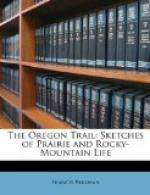We encamped that night, and marched westward through the greater part of the following day. On the next morning we again resumed our journey. It was the 17th of July, unless my notebook misleads me. At noon we stopped by some pools of rain-water, and in the afternoon again set forward. This double movement was contrary to the usual practice of the Indians, but all were very anxious to reach the hunting ground, kill the necessary number of buffalo, and retreat as soon as possible from the dangerous neighborhood. I pass by for the present some curious incidents that occurred during these marches and encampments. Late in the afternoon of the last-mentioned day we came upon the banks of a little sandy stream, of which the Indians could not tell the name; for they were very ill acquainted with that part of the country. So parched and arid were the prairies around that they could not supply grass enough for the horses to feed upon, and we were compelled to move farther and farther up the stream in search of ground for encampment. The country was much wilder than before. The plains were gashed with ravines and broken into hollows and steep declivities, which flanked our course, as, in long-scattered array, the Indians advanced up the side of the stream. Mene-Seela consulted an extraordinary oracle to instruct him where the buffalo were to be found. When he with the other chiefs sat down on the grass to smoke and converse, as they often did during the march, the old man picked up one of those enormous black-and-green crickets, which the Dakota call by a name that signifies “They who point out the buffalo.” The Root-Diggers, a wretched tribe beyond the mountains, turn them to good account by making them into a sort of soup, pronounced by certain unscrupulous trappers to be extremely rich. Holding the bloated insect respectfully between his fingers and thumb, the old Indian looked attentively at him and inquired, “Tell me, my father, where must we go to-morrow to find the buffalo?” The cricket twisted about his long horns in evident embarrassment. At last he pointed, or seemed to point, them westward. Mene-Seela, dropping him gently on the grass, laughed with great glee, and said that if we went that way in the morning we should be sure to kill plenty of game.




